
August 2020
Not everybody listening to this presentation may be fluent or even familiar with the controversies regarding The Book of Abraham. I will not attempt to summarize every criticism leveled against The Book of Abraham here, of course, but I will be addressing the primary argument that has been used against the translation of The Book of Abraham for over fifty years now. The substance of this argument has not changed nor has it been materially improved upon since it was put forth by Grant Heward and Jerald Tanner in 1968. The only noticeable changes to this argument since 1968 has been with respect to the aesthetics in presentation.[1]
A number of responses to Heward and Tanner’s theory have been put forward from 1968 through the present; however, I will not be reviewing the history of these responses and I will only touch upon a few of them briefly. My intent is to provide another piece of evidence regarding this topic that seems to have been overlooked for the past five decades. I do not expect my observations to settle the controversy or solve the mysteries of the Kirtland and Nauvoo Egyptian papers, but it is another piece of the puzzle that should help clarify and nullify Heward and Tanner’s popular theory regarding the Book of Abraham translation.

Backing up for a moment, Michael Chandler arrived in Kirtland, Ohio in late June or early July 1835 with four mummies and some papyri. Joseph and the saints purchased the mummies and papyri and the earliest contemporary source describing the content of the acquisitions comes from W.W. Phelps, who wrote a letter to his wife Sally in Missouri, three weeks after Chandler arrived. Phelps wrote, “there were two papyrus rolls, besides some other ancient Egyptian writings with them.”[2] These papyrus rolls, according to Phelps, contained the records of Joseph and Abraham – whether both were on the same scroll, or one on each is not clearly specified by Phelps. In December 1835, Oliver Cowdery wrote to William Frye, similarly stating that there were “two rolls of papyrus. . .[with] two or three other small pieces of papyrus, with astronomical calculations, epitaphs, &c. were found with others of the Mummies.” He also stated that the writings of Abraham and Joseph were, “beautifully written on papyrus with black, and a small part red ink or paint, in perfect preservation.” Again, it isn’t entirely clear whether both records were on the same scroll or on separate rolls of papyri based on these observations, but Cowdery does state that Abraham and Joseph’s writings included black and red ink.[3]
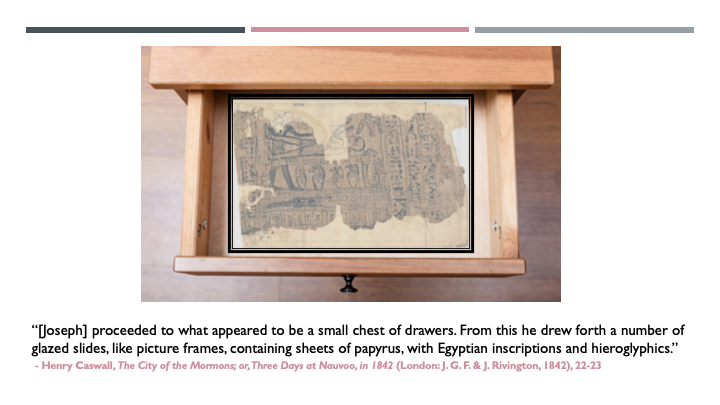
By 1842, some of the fragments of papyri were already preserved in a chest of drawers and framed in glass. Henry Caswall, an Anglican clergyman visiting Nauvoo wrote,
“[Joseph] proceeded to what appeared to be a small chest of drawers. From this he drew forth a number of glazed slides, like picture frames, containing sheets of papyrus, with Egyptian inscriptions and hieroglyphics.”[4]
In no uncertain terms, Caswall observed JSP I (or Facsimile 1 in the Book of Abraham) as part of this collection of papyrus fragments framed in glass. “Pointing to the figure of a man lying on a table, he [Joseph] said, “That is the picture of Abraham on the point of being sacrificed. That man standing by him with a drawn knife is an idolatrous priest of the Egyptians. Abraham prayed to God, who immediately unloosed his bands, and delivered him.””[5]

So no later than 1842, a number of papyrus fragments, either ends of rolls that were damaged and/or some of the other papyri that Phelps and Cowdery referred to, were preserved in glass frames within cabinet drawers. This is further confirmed two years later and a month before Joseph’s martyrdom, when Josiah Quincy, Jr. and Charles Francis Adams visited Nauvoo. Quincy wrote that, “Some parchments inscribed with hieroglyphics were then offered to us. They were preserved under glass and handled with great respect.”[6]
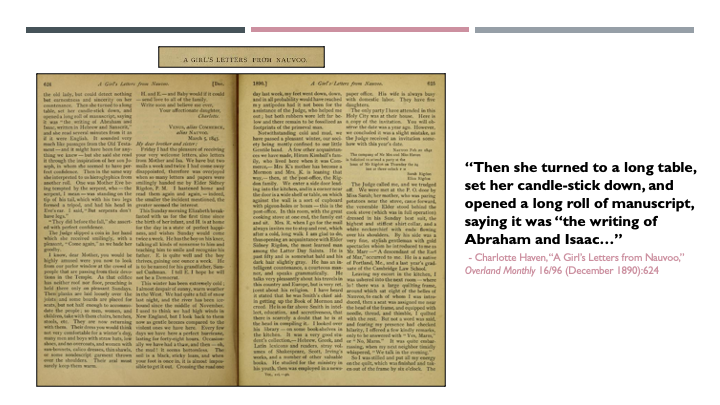
We know, however, that not all of the papyri were framed in glass. On February 19, 1843, Charlotte Haven wrote to her mother about her visit in Nauvoo and described her experience with the mummies and papyri, explaining that Lucy Mack Smith opened a long roll of papyrus on top of a long table, set her candlestick down and explained that the roll contained the writings of Abraham and Isaac (either Lucy or Charlotte probably meant Abraham and Joseph). Charlotte also mentioned seeing another roll of papyrus.[7]
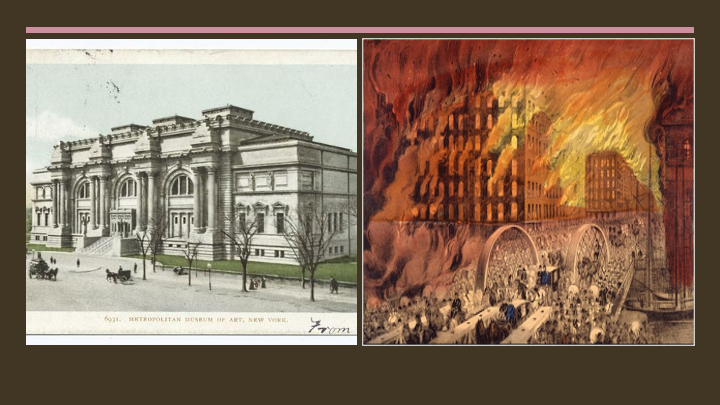
There are other eyewitness accounts, but time will not permit further exploration here. My purpose is to point out that there were two rolls of papyrus separate from the fragments of papyri that were preserved in glass frames. It seems that the fragments preserved under glass comprised the lot of papyri that were eventually sold to the Metropolitan Museum of Art in 1947,[8] while the two rolls and some other fragments would eventually end up in Wood’s Museum in Chicago,[9] and subsequently burned in the great Chicago fire of 1871.
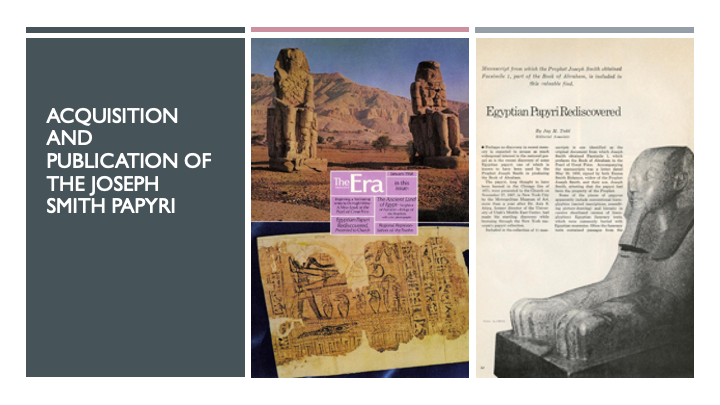

In November 1967, The Church of Jesus Christ of Latter-day Saints acquired 11 papyri fragments from the Metropolitan Museum of Art. This came as quite a surprise to church members since it was believed that all of Joseph’s papyri had been burned in the Chicago fire. Announcement and discussion of the papyri was published in the church’s January 1968 issue of The Improvement Era. The following month, in the February 1968 Improvement Era, images of the papyri were published and each papyrus fragment was numbered I through XI (papyrus fragment IX was actually recovered from the Church Historian’s office and two papyri fragments from “the Met” were labeled III-A and III-B). Later that year, Dialogue: A Journal of Mormon Thought devoted almost forty pages of their quarterly journal to discussion and partial translation of the papyri. Part of that discussion included a short article by Grant Heward and Jerald Tanner, who wrote:
“It now appears that the papyrus fragments recently recovered by the Church of Jesus Christ of Latter-day Saints include the text used by Joseph Smith to translate the Book of Abraham.”[10]
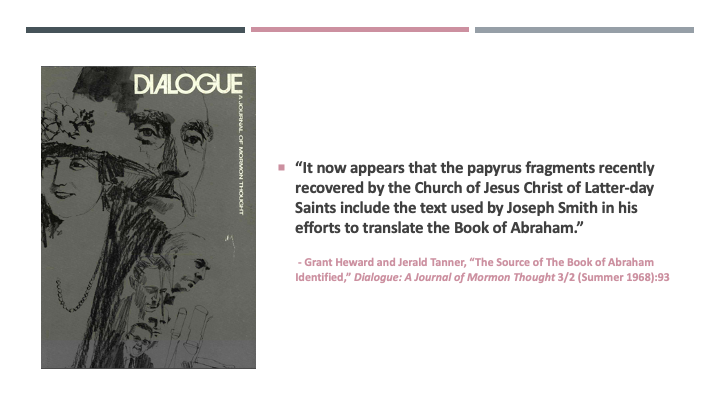
Their argument is based upon the following evidence:
- The church recovered Facsimile 1 from The Book of Abraham (known as JSP 1 based on the labeling from the February 1968 Improvement Era). Please note that Facsimiles 2 and 3 were not recovered.
- JSP I, XI, X, as well as the unrecovered Facsimile 3 from The Book of Abraham belong to the same scroll and belonged to a Theban priest named Hor. This scroll dates from the 2nd century BC.
- JSP I and JSP XI are appropriately adjacent to each other and because Facsimile 1 is at (or actually near) the beginning of the record, the text following the vignette must obviously be The Book of Abraham. According to Heward and Tanner,
- “It would seem that Joseph Smith studied this fragment and concluded that it was written by Abraham. Then Joseph, or his scribes, copied down a character or two at a time and to the right of each of each character rendered a translation of its meaning. These translations comprise the original manuscript version of the Book of Abraham.”[11]
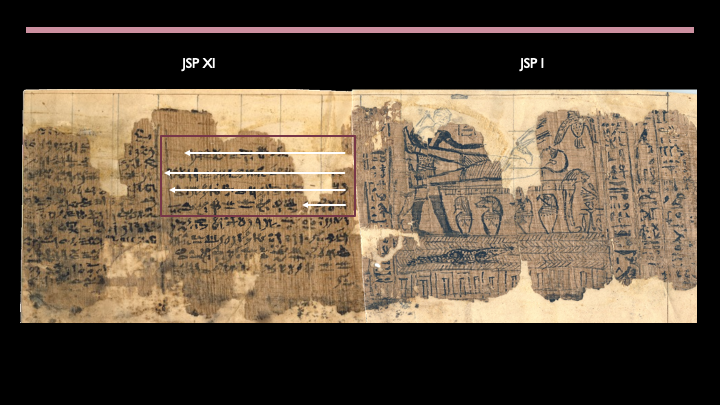
- “It would seem that Joseph Smith studied this fragment and concluded that it was written by Abraham. Then Joseph, or his scribes, copied down a character or two at a time and to the right of each of each character rendered a translation of its meaning. These translations comprise the original manuscript version of the Book of Abraham.”[11]
- So referring to JSP XI, Joseph’s scribes copied characters from right to left, top to bottom, and then juxtaposed this hieratic text next to the Book of Abraham text.
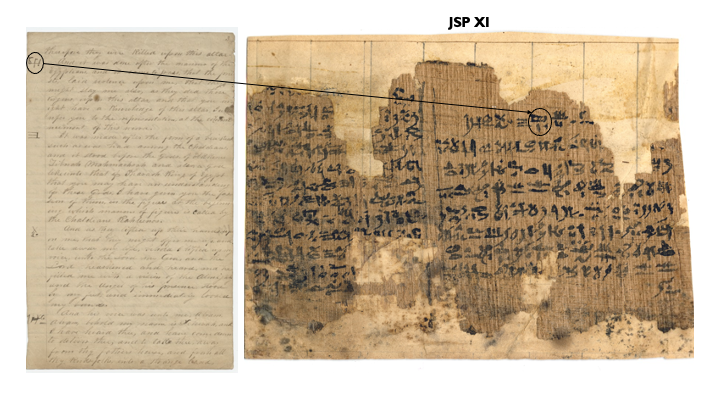
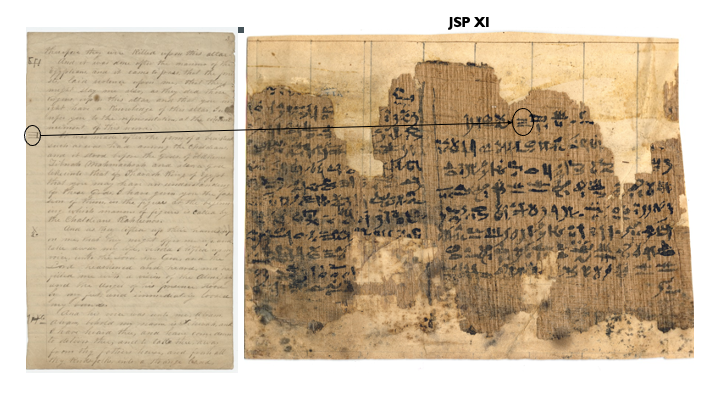
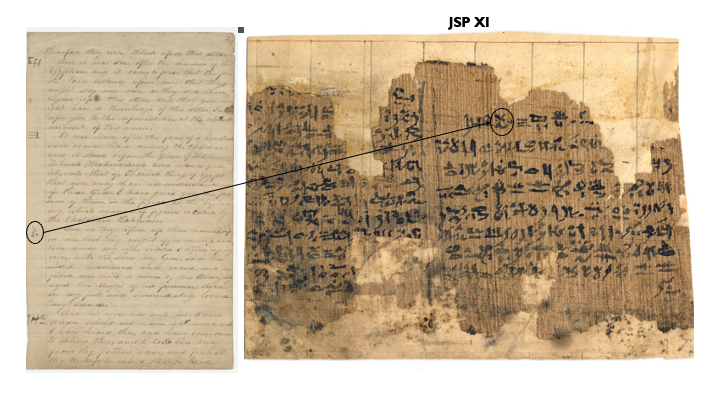
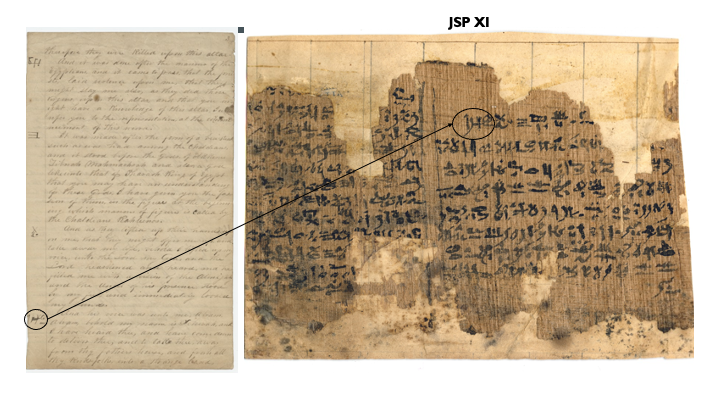
- For example, you can look at hieratic characters from JSP XI and see those same characters in the left margin of the Book of Abraham manuscripts from the “Kirtland Egyptian Papers” corpus with corresponding Book of Abraham text juxtaposed next to the characters.
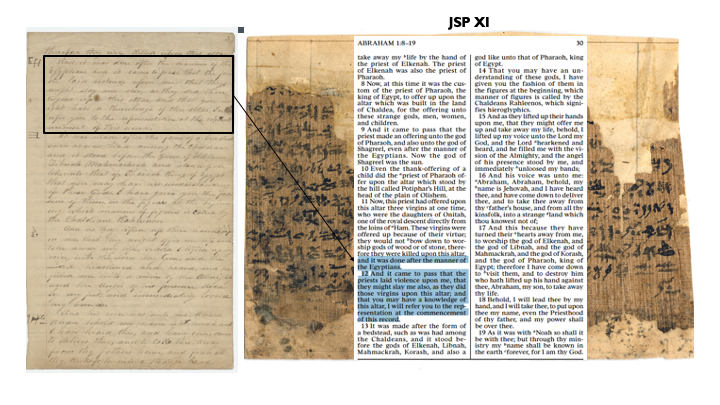
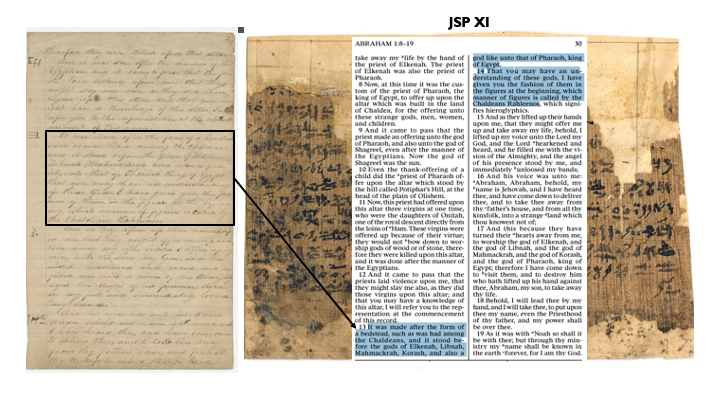
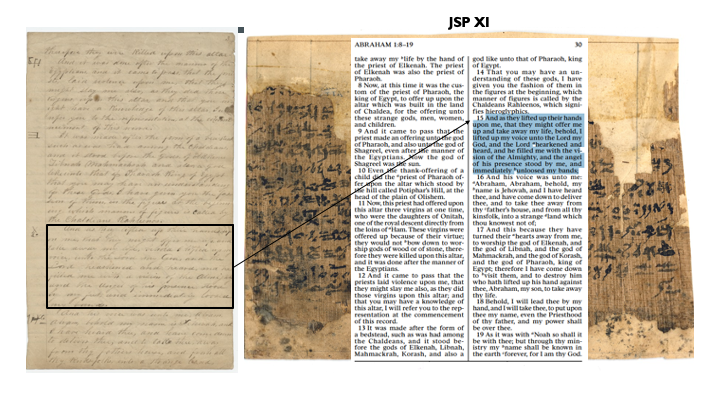
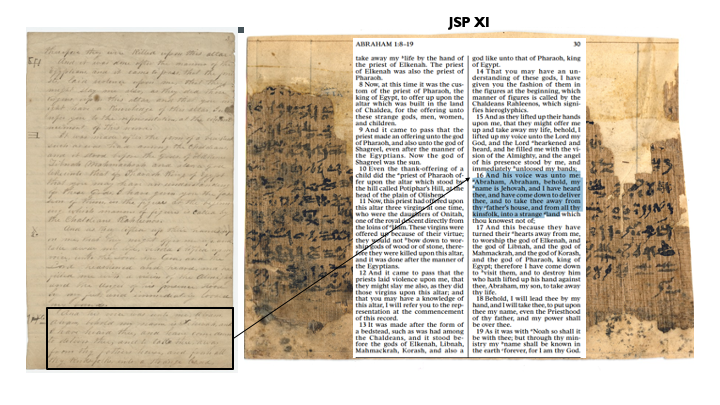
There are actually three “Book of Abraham” manuscripts within the Kirtland Egyptian Papers collection, labeled by the Joseph Smith Papers as A, B, and C. Using our current versification:
A was written by Frederick G. Williams and contained Abr 1:4-2:6.
B was written by Warren Parrish and contained Abr 1:4-2:2.
C was written by W. W. Phelps containing Abr 1:1-3 and Warren Parrish containing 1:4-2:18.
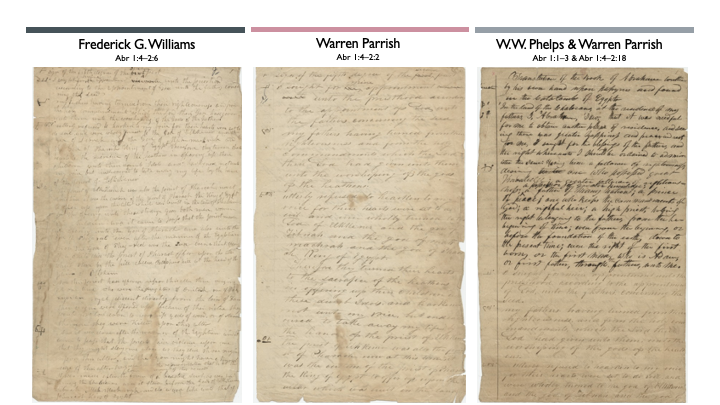
Little attention has been paid to the question of why three separate documents exist, why they cover different ranges of verses, how the similarities and differences between manuscripts can be explained, why Warren Parrish wrote two of the documents, etc. Certainly, further work remains to be done on these manuscripts. The Joseph Smith Papers has done a tremendous work in making the complete data available online and in published format in the Revelations and Translations series (volume 4). This preliminary work could be taken even further by somebody with the relevant credentials in linguistics and textual criticism.
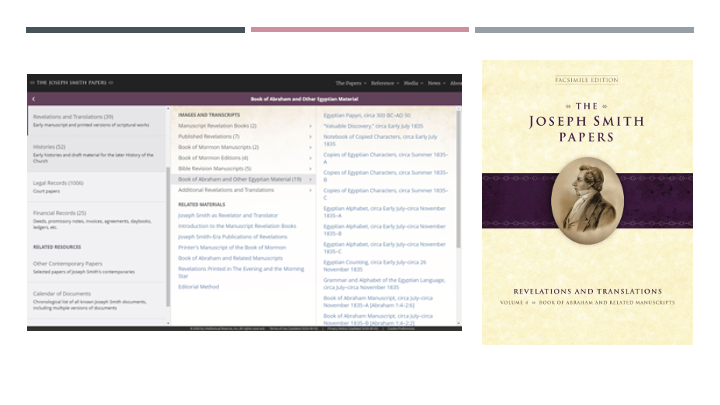
Nonetheless, these next slides shown illustrate the portion of JSP XI copied, the hieratic character presumably drawn by either Phelps, Parrish, or Williams in the Kirtland Egyptian Papers, and the Book of Abraham text next to the hieratic characters.
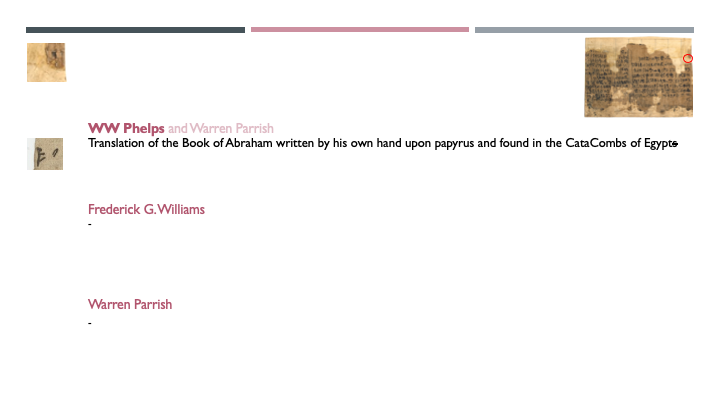
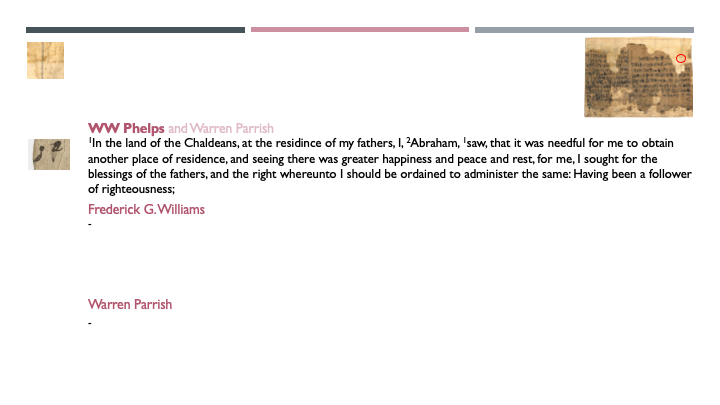

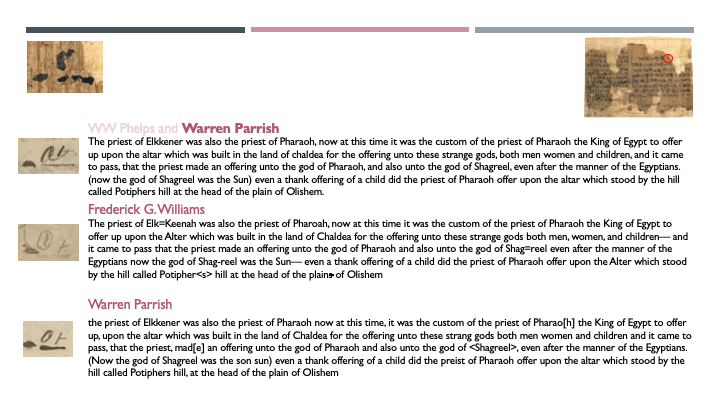
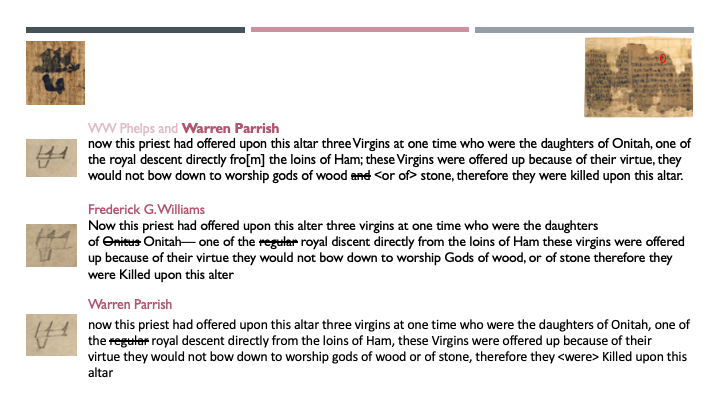


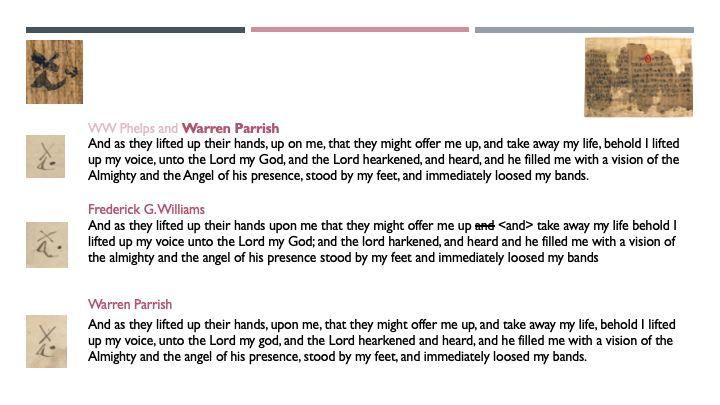
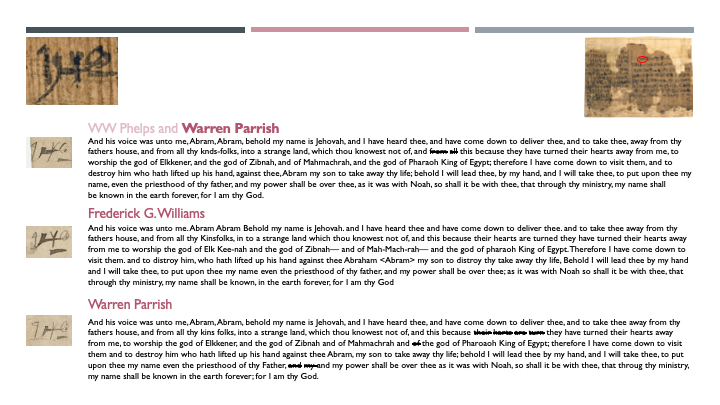
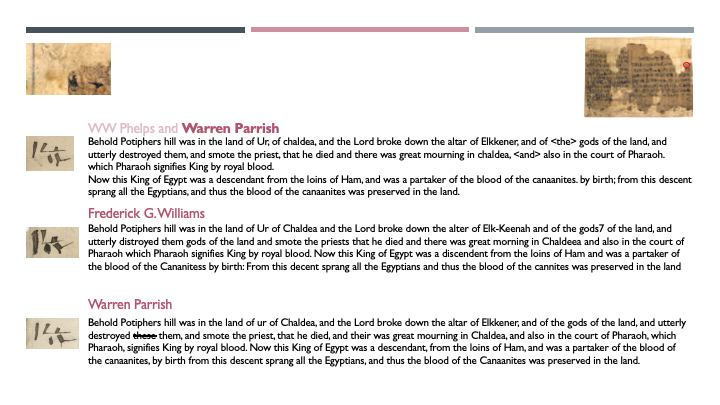
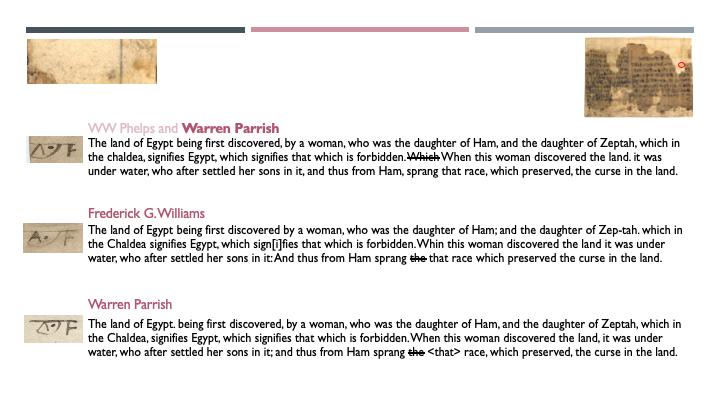
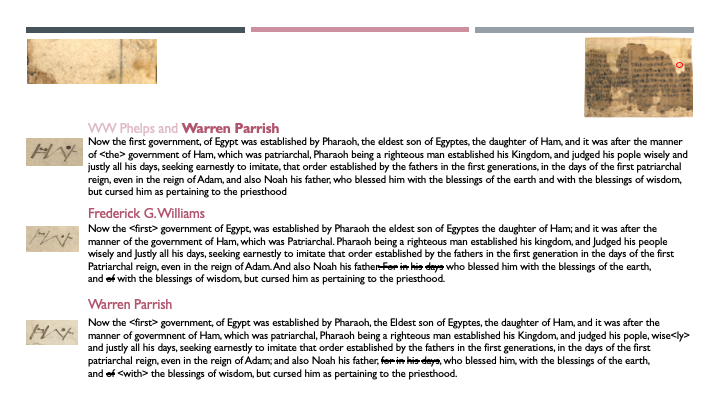
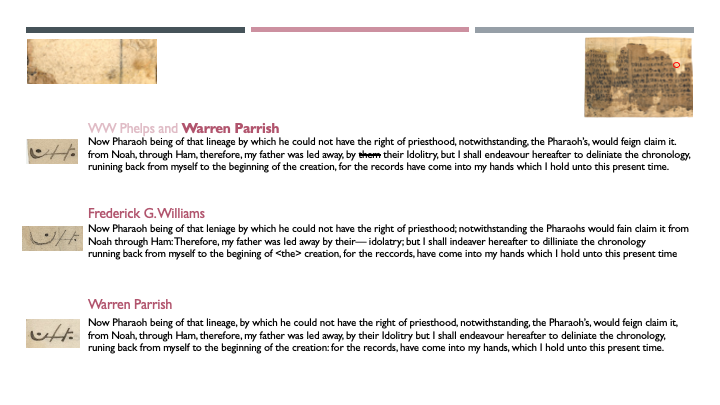
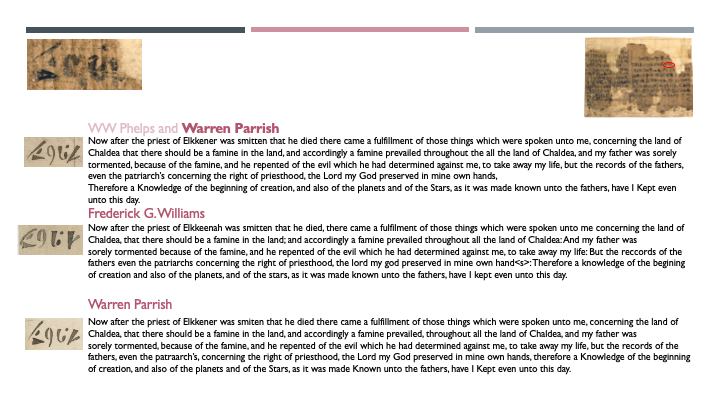
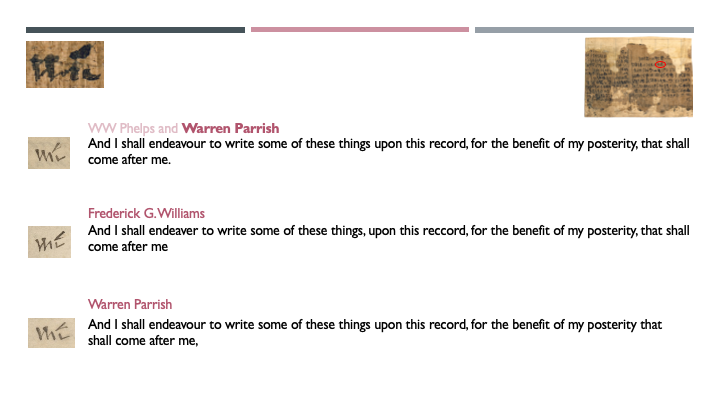
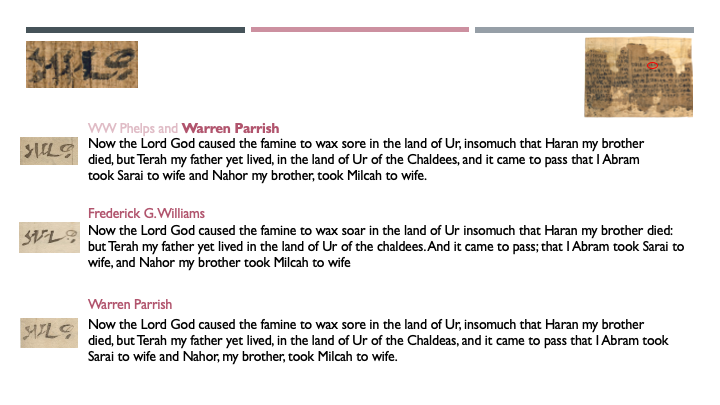
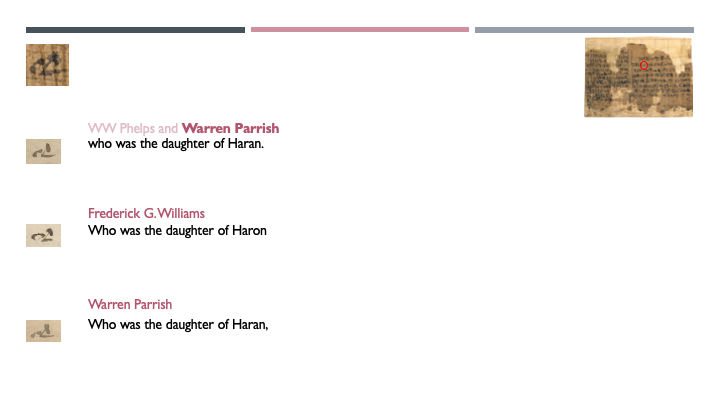

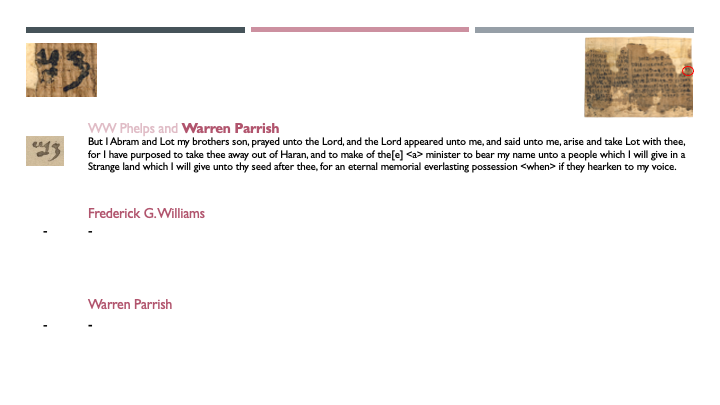
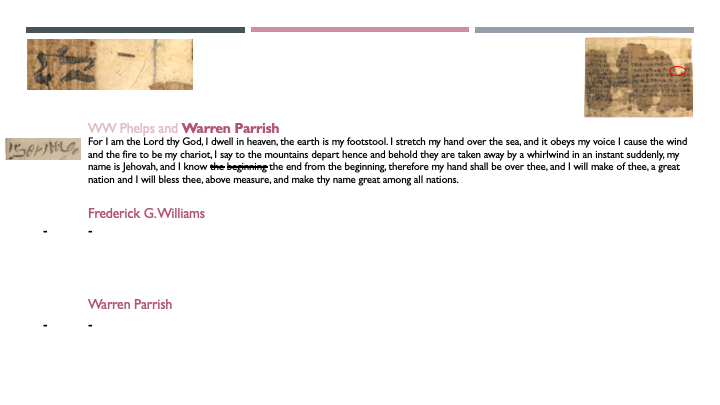
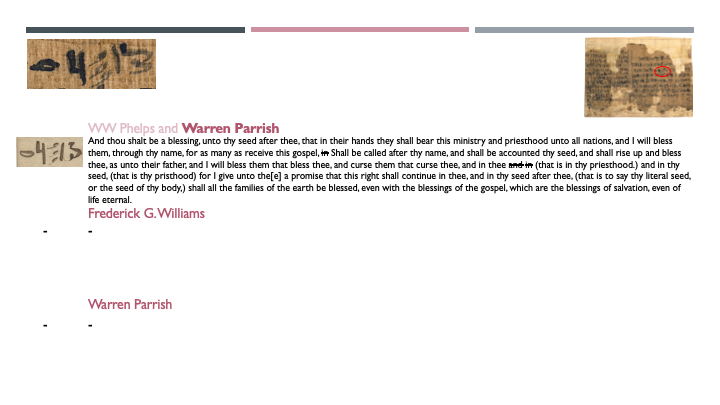
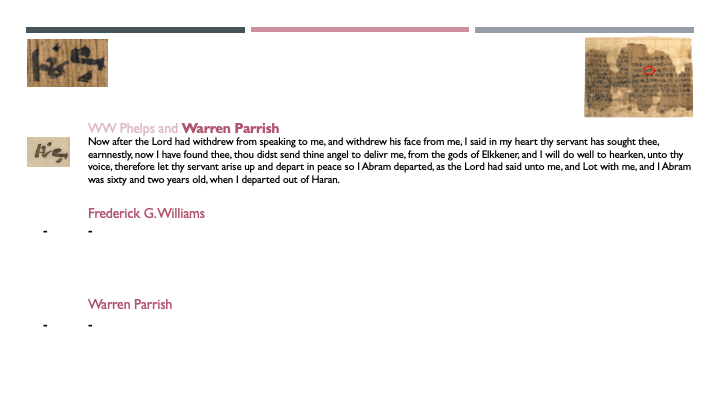
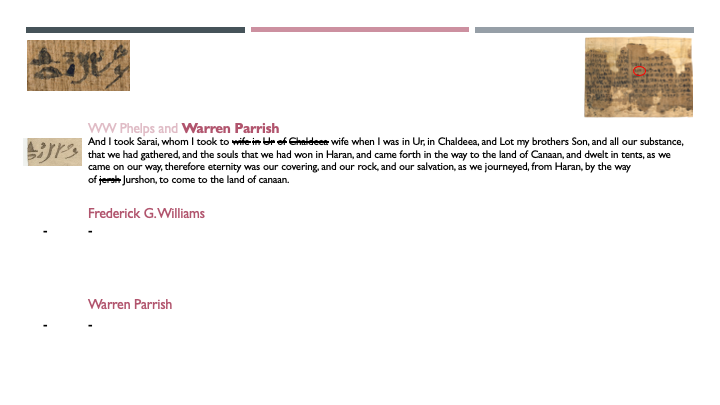
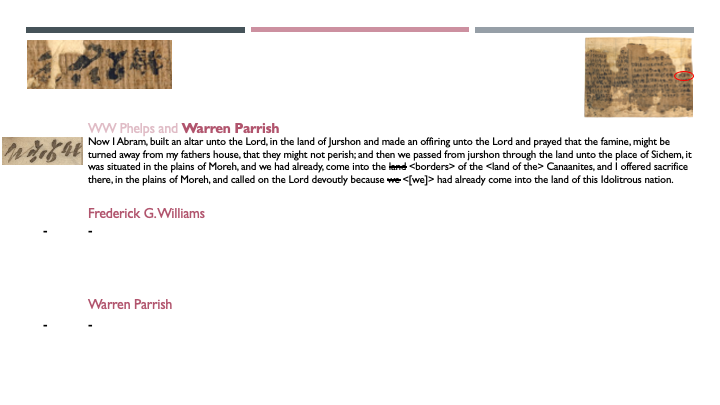
The approach is consistent for the first three and a third lines of hieratic text from JSP XI, although you’ll see that the extent of usage varies from each Book of Abraham manuscript, but in the case of Book of Abraham manuscript C, the identified hieratic characters gets us through Abraham 2:18. There is no other similar extant documents accounting for the remainder of The Book of Abraham or any further usage of the hieratic characters in this fashion with respect to the text of The Book of Abraham. This doesn’t stop Heward and Tanner from speculating though.
They wrote that, “Joseph Smith apparently translated many English words from each Egyptian character. The characters from fewer than four lines of the papyrus make up forty-nine verses of the Book of Abraham, containing more than two thousand words. If Joseph Smith continued to translate the same number of English words from each Egyptian character, this one small fragment would complete the entire text of the Book of Abraham. In other words, the small piece of papyrus pictured in illustration No. 1 appears to be the whole Book of Abraham!”[12]
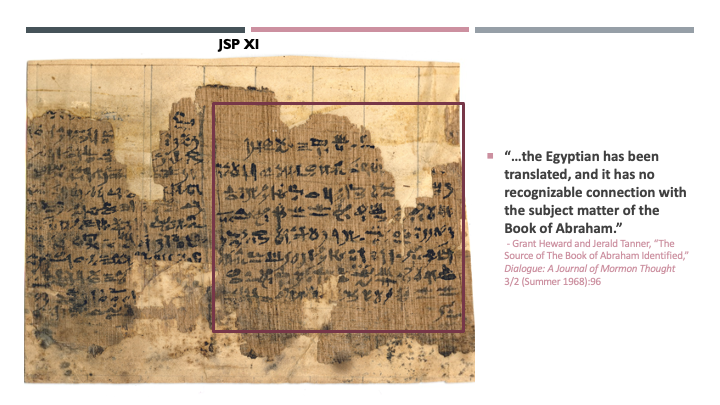
This argument is begging the question. It assumes, first, that the project is entirely Joseph Smith’s doing. Again, addressing the differences between the manuscripts, the duplication of Parrish’s work, the differences between the published Book of Abraham and the manuscripts, the methodology formulating this work, the context of the various language projects beginning in 1835, and the likeliness of a pre-existing Book of Abraham text are all separate topics; but I want to show that this data is the basis for the Heward and Tanner argument. I’ll return later to the Kirtland Egyptian Papers, but the evidence presented thus far was sufficient for Heward and Tanner to conclude that “the Egyptian has been translated, and it has no recognizable connection with the subject matter of the Book of Abraham.”[13] Therefore, based on their conclusion, Joseph was mistaken and his translation of The Book of Abraham does not match the translation made by Egyptologists from the same hieratic text, so Joseph’s translation wasn’t a real translation. This evidence would seem to be a slam dunk.
It is this same argument that has been repeated for over fifty years and has heavily influenced the interpretation of the papyri for many who have lost their faith. According to an unsolicited survey and report on faith crises in 2013 with over 3,000 responders, The Book of Abraham tied for 1st place as the most important church history reason for a faith crisis.[14] This is quite unfortunate.
So let’s take a closer look now and make some observations.
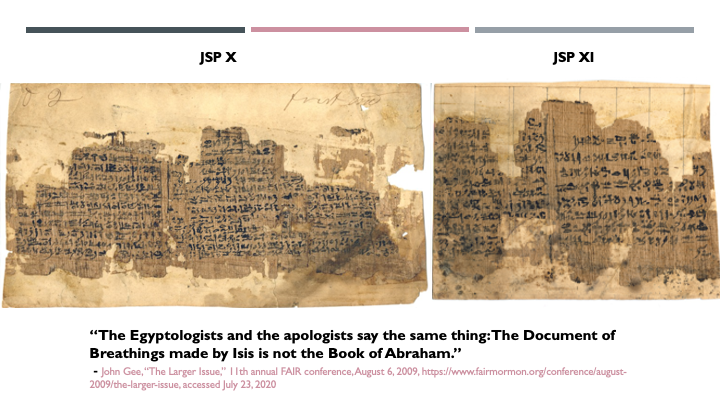
As Kerry Muhlestein pointed out in 2005, “Since the modern discovery of the Joseph Smith Papyri, the text has been translated by Richard A. Parker, Klaus Baer, Hugh W. Nibley, Robert K. Ritner (twice) [and a third time now following Muhlestein’s article], and Michael D. Rhodes.”[15] Three of those Egyptologists are not and have never been members of The Church of Jesus Christ of Latter-day Saints, two of them are Latter-day Saints. All of them are legitimate Egyptologists and all of them agree that JSP I, XI, X, and Facsimile 3 is from Hor’s copy of the Document of Breathings Made by Isis. As John Gee has stated, “The Egyptologists and the apologists say the same thing: The Document of Breathings made by Isis is not the Book of Abraham.”[16] In other words, the primary argument that Joseph could not translate because the hieratic text that he is presumed to have translated does not match the translation from Egyptologists, is a straw man argument. Both sides (generally speaking) agree that JSP XI is not The Book of Abraham.
The argument all along has hinged upon the Book of Abraham manuscripts from the Kirtland Egyptian Papers. Heward and Tanner’s argument is entirely dependent on The Book of Abraham being derived from the hieratic characters from JSP XI. While we don’t have any commentary from Joseph Smith regarding these Book of Abraham manuscripts, we also do not have any commentary on these manuscripts from his closest friends, counselors, or scribes, such as W. W. Phelps, Frederick G. Williams, Oliver Cowdery, John Whitmer, or Sidney Rigdon, although we do have a brief, but vague comment by Warren Parrish in 1838, who wrote, “I have set by his [Joseph’s] side and penned down the translation of the Egyptian Hieroglyphicks as he claimed to receive it by direct inspiration of Heaven.”[17] This is relevant, to be sure, but inconclusive as to whether he was referring to the Book of Abraham manuscripts, or other Egyptian materials whether extant or no longer extant. What is also generally missing is relevant context, but again we’ll return to this later.
Ironically, however, what we do have is commentary directly from Joseph Smith about JSP XI, and it was Grant Heward and Jerald Tanner who actually made this observation, but they stopped just short of its implications, just as every single one of their successors have done. Tanner and Heward wrote, “It is interesting to note that not only the manuscripts of the Book of Abraham but also Facsimile No. 2 includes portions of this “Book of Breathings.” Evidently the original of Facsimile No. 2 was damaged…. The missing areas on this drawing have been filled in with insertions from other documents to make Facsimile No. 2 as it now exists…”[18]

They are referring to a drawing from the Nauvoo Egyptian Papers of a damaged hypocephalus. The actual hypocephalus was presumably burned in the Chicago fire as well, but this drawing, which clearly became Facsimile No. 2 in The Book of Abraham has been preserved. Willard Richards probably drew the hypocephalus since he wrote the explanations for the figures of this facsimile in the Nauvoo Egyptian Papers. The lucanae for Facsimile No. 2, did indeed come from other parts of the Joseph Smith Papyri collection. I’ve highlighted 1/3rd of the hypocephalus rim or Figure 18 (the right hand side of the rim), and half of Figures 13, 14, and 15 on the right-hand side as well, just as Heward and Tanner depicted in their 1968 article. These highlighted portions can all be traced back to JSP XI.
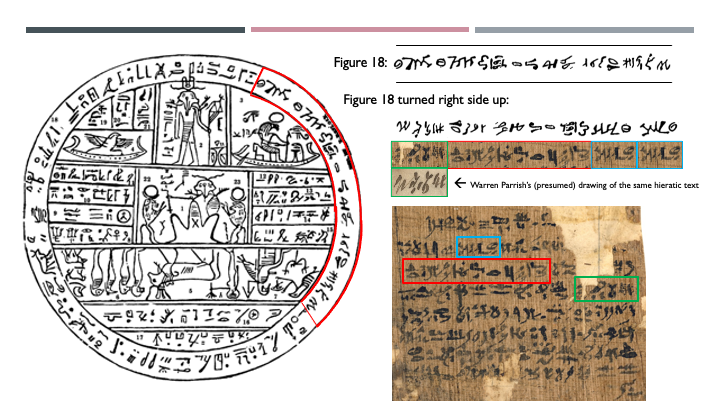
Starting with the rim, or Figure 18, I’ve laid the semi-circular text in a horizontal row. The text was inserted upside down, but when turned right side up and flipped around, the text can be aligned with hieratic text in JSP XI from rows 2, 3, and 4. The transfer of hieratic characters to the hypocephalus isn’t as clean as one might have hoped for, but a clear match can be made when looking closely at JSP XI and Facsimile No 2, and in the case of JSP XI row 4, from Book of Abraham Manuscript C.
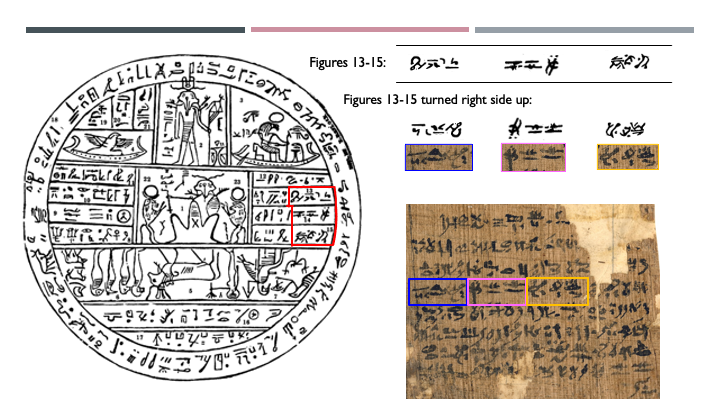
Similarly, on Figures 13, 14, and 15, these figures need to be turned right side up and flipped around as well (although the numbering from Figures 12 through 15 in the original 1842 publication of the Book of Abraham was printed upside down as well, potentially indicating that the text was deliberately inserted upside down), nonetheless, the text can be aligned with the hieratic text in JSP XI, row 4. Again, the transfer of hieratic characters to the hypocephalus isn’t as clean as one might have hoped for, but a match can be made when looking closely at JSP XI and Facsimile No 2.
Based on Heward and Tanner’s theory, using our current versification, Abraham 2:1 through most of 2:2, and half of 2:9 through 2:18 were all included in Facsimile No. 2. Fortunately, we know what Joseph had to say about this text since he provided the explanations to Facsimile 2.
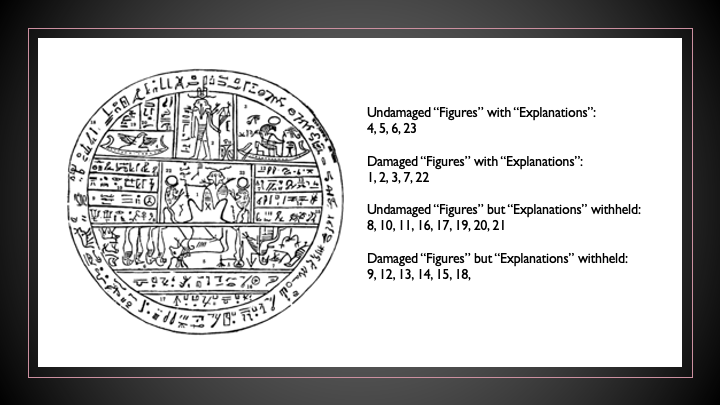
Interestingly, looking at the undamaged portions of the hypocephalus and the damaged portions (but filled in with various Egyptian hieroglyphic and hieratic characters), Joseph chose to comment on some “Figures” and refrain from commenting on others. Sometimes he provided explanations for undamaged figures, and sometimes he refrained from explaining undamaged figures. Sometimes he provided explanations for damaged figures, and other times he refrained from explaining damaged figures.
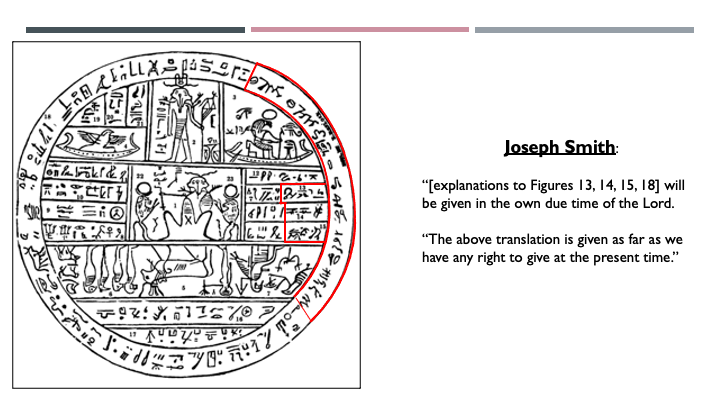
It just so happens that literally every Figure containing any hieratic text from JSP XI, Joseph’s response is that the explanations “will be given in the own due time of the Lord.” And he concludes by saying, “The above translation is given as far as we have any right to give at the present time.” In other words, literally all of the JSP XI hieratic characters included in Facsimile 2, Joseph Smith deliberately declined from commenting upon because he believed that the translation would at some future time be given in the own due time of the Lord. Joseph clearly indicates that he did NOT translate JSP XI.
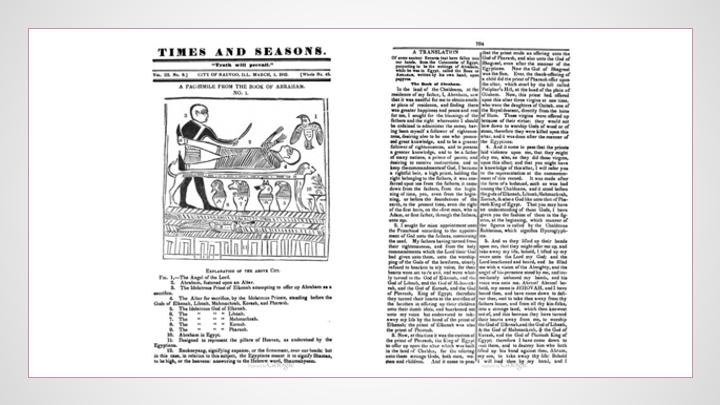
Especially when critics want to put Joseph at the helm of the extant Book of Abraham Manuscripts using JSP XI, the irony becomes apparent with the publication of the Book of Abraham and its incorporated facsimiles. The timing of these “Explanations” are interesting. On March 1, 1842, Joseph Smith, as editor of the Times and Seasons, published the first installment of the Book of Abraham, which, in our modern versification, included Facsimile 1 with accompanying explanations, and Abraham 1:1 through 2:18. This first installment constitutes the entirety of the Abrahamic text from the extant Book of Abraham Manuscripts from the Kirtland Egyptian Papers.
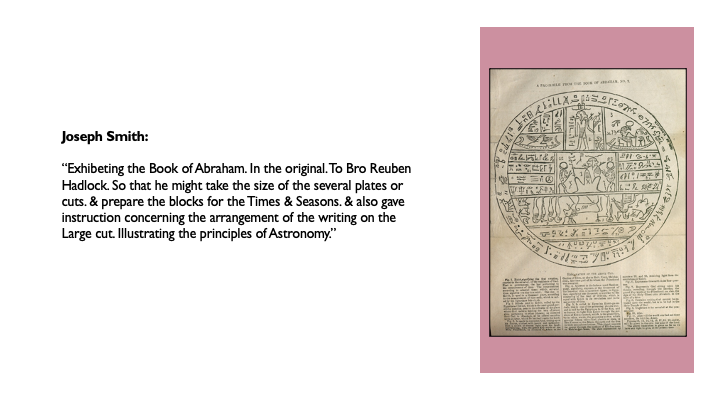
A few days after the first installment was published, Joseph Smith spent time with Reuben Hedlock: “Exhibeting the Book of Abraham. In the original. To Bro Reuben Hadlock. So that he might take the size of the several plates or cuts. & prepare the blocks for the Times & Seasons. & also gave instruction concerning the arrangement of the writing on the Large cut. Illustrating the principles of Astronomy.”[19]
Approximately two weeks later, Facsimile 2 with its accompanying explanations and Abraham 2:19 through 5:21 (the end of our Book of Abraham) was published (and the third facsimile was published in May 1842 with its accompany explanations). So according to Heward and Tanner, Joseph Smith published his translation of the first 3 and 1/3rd lines of hieratic text from JSP XI as Abraham 1:1 – 2:18 on March 1, 1842, only to include half of those hieratic characters on Facsimile 2 with the admonition that the explanation for these characters would be given in the due time of the Lord, and that he had no right to translate those characters at the present time.
My argument and rebuttal to Heward and Tanner, and the hundreds of accounts since 1968 by others who have repeated this argument is that Joseph Smith concretely provided direct evidence in Facsimile 2 that he never translated JSP XI, and that the answer has been under our heads this entire time, if we would have taken Heward and Tanner’s work one step further. Additionally, related to Heward and Tanner’s work, it should still be noted that more than fifty years later, relatively little work, piecemeal at best, has actually been done on the Kirtland and Nauvoo Egyptian Papers. That they have been documented and published now provides the means to study them in depth.
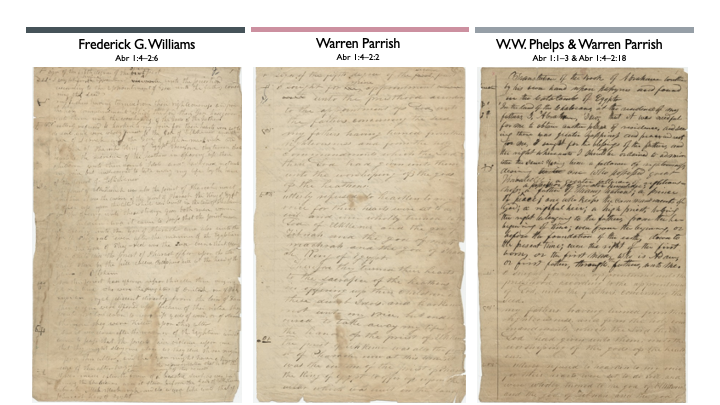
While an in-depth investigation of the Kirtland Egyptian Papers is beyond the scope of this presentation, I would simply point out a few things:
- Samuel Brown points out that W. W. Phelps interest in Egyptology began as early as July 1834, since he published that “Egyptians could astonish the universe . . . concealing their arts in mysterious characters or hieroglyphics.”[20] Phelps seems to have had a strong level of influence with respect to the Egyptian records and manuscripts.
- In W. W. Phelps biography, Bruce Van Orden noted that Ezra Booth claimed Phelps had boasted of believing he was a master of fourteen different languages.[21]
- Will Schryver has previously pointed out that some of the Egyptian documents contain foreign characters like Arabic, and cryptic characters like Masonic cyphers. He also pointed out that the relationship between the collection is far from being clear at this point.
- The Egyptian translation project took place alongside an interest in the Adamic or Pure Language, and that there is some relationship between the Egyptian records and efforts with this pure language project. Sam Brown has done excellent work in this regards and his publications should be further pursued.
- The Egyptian translation project also coincided with Oliver Cowdery’s purchase of “Hebrew grammars and lexica, in addition to Greek primers and “Webster’s English Lexicon.””[22] This was followed shortly thereafter with the hiring of Joshua Seixas to teach Hebrew.
The combination of these factors points towards the secular efforts to understand foreign languages and provides some basis for understanding the Kirtland Egyptian Papers. In combination with these factors and the evidence I’ve discussed thus far, this then, should give sufficient pause for thought regarding the intent, purpose, method, and participation regarding the Kirtland Egyptian Papers.
Now aside from this, we know from eye-witness accounts that the record of Abraham and Joseph contained black and red ink. Hor’s Document of Breathings Made by Isis has no rubrics (red ink) in any of its extant papyri fragments.
When the text in Abraham 1:12 and 1:14 refers the reader to Facsimile 1, we are talking about hieratic characters that are three inches away from the vignette, which hardly needs to be called out if the vignette had a direct relationship with the text nearby.
Next, as has been pointed out by others, “Shinehah” which appears in Abraham 3:13, also showed up in the August 1835 Doctrine and Covenants in several instances. Warren Parrish, whose writing comprises the majority of the Book of Abraham manuscripts, didn’t even arrive in Kirtland until October or November 1835, thus suggesting that translation through Abr 3:13 preceded the Book of Abraham manuscripts.

Further, if Joseph thought he was translating the Book of Abraham following Facsimile 1 in the Book of Breathings, why didn’t he start with the text immediately before or immediately after the vignette on the papyri? In fact, from the Kirtland Egyptian Papers, we have some of these hieratic characters written down on the “Egyptian Alphabet” documents with no explanation, translation, or other commentary whatsoever. Thanks to the work done by the Joseph Smith Papers in the Revelation and Translations Series Volume 4, we have clear indication that the characters adjacent to the lion couch scene (or Facsimile 1) in Hor’s Book of Breathings have no translation whatsoever in the Kirtland or Nauvoo Egyptian Papers. This further points us away from the idea that the text next to Facsimile 1 was the basis for The Book of Abraham, but was the project of some other, but related effort.
The fact that JSP XI is included in Facsimile 2 and Joseph explained that he was not at liberty to translate these texts, in combination with all of the other information provided leads us to believe that “except for those willfully blind, the case is far, far from closed.”

By addressing part of the problem in the primary argument regarding the translation of The Book of Abraham, I hope this evidence from the hypocephalus, the evidence that has been under our heads this whole time, adds some important insight to help alleviate concerns that tend to arise when members are confronted with the primary controversy surrounding The Book of Abraham. My hope is that this additional evidence will help improve faith in the Prophet Joseph Smith, cause Latter-day Saints to be more discerning when met with critical arguments, and inspire greater due diligence when confronted with information that they do not have answers to.
Thank you.
Q&A
Q 1: What is your opinion of the books that claim immediately that the Book of Abraham can’t be true because Joseph Smith didn’t translate it right? You said it in your presentation but go ahead and say it again in short English.
A 1: I am not making any statements as to what the current Egyptian Papers are intending to accomplish, but my argument, plain and simple, is that the papyri fragment known as JSP 11 has text on Facsimile 2 and Joseph Smith deliberately declined from translating that text, for providing an explanation of Facsimile 2. So if there is any concrete evidence regarding how Joseph Smith felt regarding JSP 11, we get that from his explanation of Facsimile 2.
So what W. W. Phelps, and Frederick G. Williams, and Warren Parrish were trying to accomplish – I think my point is that there is much work that needs to be done there still, to help us get a better understanding of the context of the purpose and the methodology and the intent of what they were trying to accomplish, why it is incomplete, why there are multiple copies from Warren Parrish, why those copies differ from each other. There is just a lot more work there to be done.
I think the argument that JSP 11 is the Book of Abraham is a surface argument. It has no depth. It says, “Look, this and this and this match, so therefore, this is the translation.” But it ignores all other relevant context.
[Scott Gordon: So it reinforces, as you stated, John Gee’s argument that we all agree, both sides agree, that that document is not where the Book of Abraham came from.]
I agree with that 100%. The Book of Abraham did not come from JSP 11. Now I don’t know whether the Book of Abraham came from hieratic text from other papyrus scrolls that we no longer have, or if there is some catalyst theory – we know he got his translation by revelation – but I do not have a conclusion on that matter at this time, other than simply saying that it seems clear to me that JSP 11 is specifically not the Book of Abraham.
Q 2: So what do you say to those people who read in one of the books on the Book of Abraham that allegedly prove the Book of Abraham not being a translation and they left the Church because of that? I have talked to some of these people and that was their issue, that was their silver bullet. They learned the Book of Abraham was not a translation of those papyri and so they left.
A 2: There are, perhaps, two answers. For whatever reason, the missing scroll theory seems to become pejoratively spoken of, recently. And I think there is still work to do there. Obviously scholars who are qualified in that arena have done work and are continuing to do work in answering that.
In the Joseph Smith Papers Conference in 2018 there were some fantastic talks given there. Some of the things that were pointed out in that conference, for example, was that Joseph Smith’s method of translation seemed to vary over time, meaning with the Book of Mormon he had the Urim and Thummim or interpreters, and he had a seer stone that he used to translate the Book of Mormon. [Transcriber’s note: originally Barker inadvertently said Book of Abraham, but he corrected this to say Book of Mormon.]
Then with the Book of Abraham in 1835, in the Book of Abraham manuscripts, Joseph’s interests went in many directions. He got a Hebrew grammar and lexicon; he got a Greek grammar or lexicon, I don’t recall which. He was working with W. W. Phelps, who claims to know 14 languages, who took an interest in hieroglyphics, prior to receiving the papyri. So it seems to have been a different effort regarding the actual documents that we have.
I think there is some evidence that Joseph Smith received the Book of Abraham either by the seer stone that he had, or by direct revelation. The seer stone was mentioned by either Warren Parrish or Wilford Woodruff.
We also have the scenario of Doctrine and Covenants Section 7 where there was text that Joseph Smith did not have present with him. It was written by John; and Joseph Smith provided the translation to it.
So I think our interpretation of what it means to have revelation and translation: there is some nuance there, and it is not necessarily a black and white issue, especially since none of us was involved in those projects.
We see how Joseph Smith uses that vernacular over time. He seems to have no problem adjusting the results. For example, if the text for both the Book of Abraham manuscripts in 1835 comprised the actual Book of Abraham, he says he was translating it again in 1842. The 1835 manuscript never says in the heading that it is purported to be written by Abraham. During the publication in 1842, Joseph adds in the header that this is text purporting to be written by the Patriarch Abraham.
[Scott Gordon: But that was added later.]
It was added later.
My point is that people are concerned about “Was this translated this way, or this way?”
I think we need to get a better understanding of what it means when Joseph uses the word translate. In the case of the Book of Abraham we have very little evidence regarding what we actually have as the Book of Abraham.
Q 3: Do you have any insight in the other figures in Facsimile 2 that Joseph Smith declined to translate?
A 3: I think that is a great question and honestly I don’t think I could answer that very well at this time; maybe another day.
Q 4: What do you think is the strongest evidence for the missing scroll theory?
A 4: Well, we certainly know that there were scrolls that were burned in the Chicago fire.
Again we have several instances where eye-witnesses refer to the record of Abraham and Joseph being in black and red ink. Some have argued that some of that is within the current possession, in the Church’s current papyri.
I think that the work that has been done, and there has been back and forth regarding the length of the scrolls, I am not a mathematician, so I would decline on opining on that.
But I think John Gee’s article of Formulas and Faith [https://scholarsarchive.byu.edu/cgi/viewcontent.cgi?article=1497&context=jbms] where he tests that formula on an existing scroll, and provides the idea that the length of scroll fits within a range, rather than a very specific number, is much better than using photography or a photograph of rolled up papyrus fragments in determining the length of the scroll.
Then you also have eye-witness accounts: What does it mean to have a long roll? Then Joseph F. Smith reported to Preston Nibley, who reported to Hugh Nibley, so it is rather late, but it refers to the papyrus roll that unrolled from one end to another. Joseph F. Smith was quite young at the time.
There seems to be evidence that there certainly was a much larger extent of papyri that we don’t have, that Joseph did, than what we do have now.
Q 5: Because the characters in Facsimile 2 and papyrus 11 are the same, and because Joseph Smith did not provide an explanation for the figures, that is why Joseph Smith could not, or did not, translate it. Is that an accurate representation of your argument?
A 5: Yes.
Q 6: Is there a possibility that while Joseph Smith was looking at the writings, It triggered him to receive revelations about Abraham, thus seeing the information as a blessing, rather than a false document, to be a matter of faith, rather than a matter of science?
A 6: I have no problem with that argument other than again forJSP 11, where he used those same figures, the same hieratic characters on Facsimile 2, and said that he could not translate those at this time, because they were to be given in the own due time of the Lord.
So I am not opposed to the idea that Joseph Smith was looking at Egpytian papyri and some portion of it acted as a catalyst to giving him a revelation of the Book of Abraham.
I am not opposed to that possibility, but I have no conclusion on it. It is simply still a matter of conjecture.
Q 7: What resources do you recommend for learning more about the translations of facsimiles?
A 7: That is a great question. Michael D. Rhodes translated Hypocephalus, the Facsimile #2. I think that was in 1977, if I remember right, and then did it again 20 years later, with an update.
Michael D. Rhodes translated the Hor Book of Breathings, or the Document of Breathings written by Isis. That is published in the Studies in the Book of Abraham series. [https://press.uchicago.edu/ucp/books/series/BYU-SBA.html]
We also have, forgive me, I have not finished it yet, but Clinton Barney just finished a thesis on Facsimile 3, in which he includes 32 of the 33 extant copies of the Book of Breathings.
I believe there is a translation of Facsimile 3 in there as well.
There are external sources, of course, regarding the Facsimiles, but I would start with Michael Rhodes and go from there.
Q 8: Here is a good summing up question. Do you believe the Book of Abraham is true?
A 8: Of course. Absolutely.
[Transcriber’s note: Lightly edited for clarity and readability.]
Sources
[1] Notwithstanding Christopher C. Smith’s, “”That Which is Lost”: Assessing the State of Preservation of the Joseph Smith Papyri,” The John Whitmer Historical Association Journal 31/1 (Spring/Summer 2011):69-83
[2] W.W. Phelps to Sally Phelps, “Letters of Faith From Kirtland,” The Improvement Era 45/8 (August 1942):529
[3] Oliver Cowdery to Wm. Frye Esq., Messenger and Advocate 2/3 (December 1835):234; Robert Horne provided some reminiscences of Nauvoo in 1893, noting that, “The records which I saw were some kind of parchment or papyrus, and it contained writing in red and black. Mother Lucy told me that one was the writings of Abraham and the other the writings of Joseph, who was sold in Egypt,” in Robert Horne, “Reminiscences of the Church in Nauvoo,” The Latter-Day Saints’ Millennial Star 55/36 (September 1893):585. This seems to indicate that the patriarchal writings were on both scrolls, but Abraham’s writings is again identified on a scroll with black and red ink.
[4] Henry Caswall, The City of the Mormons; or, Three Days at Nauvoo, in 1842 (London: J. G. F. & J. Rivington, 1842), 22
[5] Ibid, 22-23
[6] Josiah Quincy, Figures of the Past: From the Leaves of Old Journals (Boston: Roberts Brothers, 1883), 386; see also Henry Adams, “Charles Francis Adams Visits the Mormons in 1844,” Proceedings of the Massachusetts Historical Society 68:284-285
[7] Charlotte Haven, “A Girl’s Letters from Nauvoo,” Overland Monthly 16/96 (December 1890):624
[8] John Gee, An Introduction to The Book of Abraham (Provo, UT: Religious Studies Center, Brigham Young University, and Salt Lake City: Deseret Book, 2017), 7
[9] Ibid, 6
[10] Grant Heward and Jerald Tanner, “The Source of The Book of Abraham Identified,” Dialogue: A Journal of Mormon Thought 3/2 (Summer 1968):93
[11] Heward and Tanner, “The Source of the Book of Abraham,” 93
[12] Grant Heward and Jerald Tanner, “The Source of The Book of Abraham Identified,” Dialogue: A Journal of Mormon Thought 3/2 (Summer 1968):95; Hugh Nibley responded to this in 1968 and again in 1975, asking, “How on earth could Joseph Smith or anybody else have derived a condensed and detailed account of fifty pages from less than twenty hieratic signs? How could such signs have suggested a history, let alone contain it? Why must a hard-working author derive his whole book from less than two dozen signs, when thousands were at his disposal?” Hugh W. Nibley, The Message of the Joseph Smith Papyri: An Egyptian Endowment (Salt Lake City: Deseret Book Company, 1975), 1
[13] Grant Heward and Jerald Tanner, “The Source of The Book of Abraham Identified,” Dialogue: A Journal of Mormon Thought 3/2 (Summer 1968):96
[14] Greg Prince, et al, LDS Personal Faith Crisis: Prepared for President Dieter F. Uchtdorf, Proprietary and Confidential (Privately e-published, 2013), 32; https://faenrandir.github.io/a_careful_examination/documents/faith_crisis_study/Faith_Crisis_R28e.pdf, accessed July 12, 2020. This “church history” reason seems to still be true in 2019, per Jana Riess, The Next Mormons: How Millennials Are Changing the LDS Church (New York: Oxford University Press, 2019), Table 11.4
[15] Kerry Muhlestein, “The Book of Breathings in Its Place,” The FARMS Review 17/2 (2005):473
[16] John Gee, “The Larger Issue,” 11th annual FAIR conference, August 6, 2009, https://www.fairmormon.org/conference/august-2009/the-larger-issue, accessed July 23, 2020
[17] Warren Parrish, letter to the editor, Painesville Republican, 15 February 1838, 3; as cited in Gee, An Introduction to the Book of Abraham, 20
[18] Heward and Tanner, “The Source of The Book of Abraham Identified,” 96
[19] Andrew H. Hedges, Alex D. Smith, Richard Lloyd Anderson, Eds., The Joseph Smith Papers: Journals, Volume 2 (December 1841 – April 1843), (Salt Lake City: The Church Historian’s Press, 2011), 40
[20] Samuel Brown, “The Translator and the Ghostwriter: Joseph Smith and W. W. Phelps,” Journal of Mormon History 34/1 (Winter 2008):35
[21] Bruce A. Van Orden, We’ll Sing and We’ll Shout: The Life and Times of W. W. Phelps (Provo, UT: Religious Studies Center, Brigham Young University, 2018), 43
[22] Brown, The Translator and the Ghostwriter,” 36
